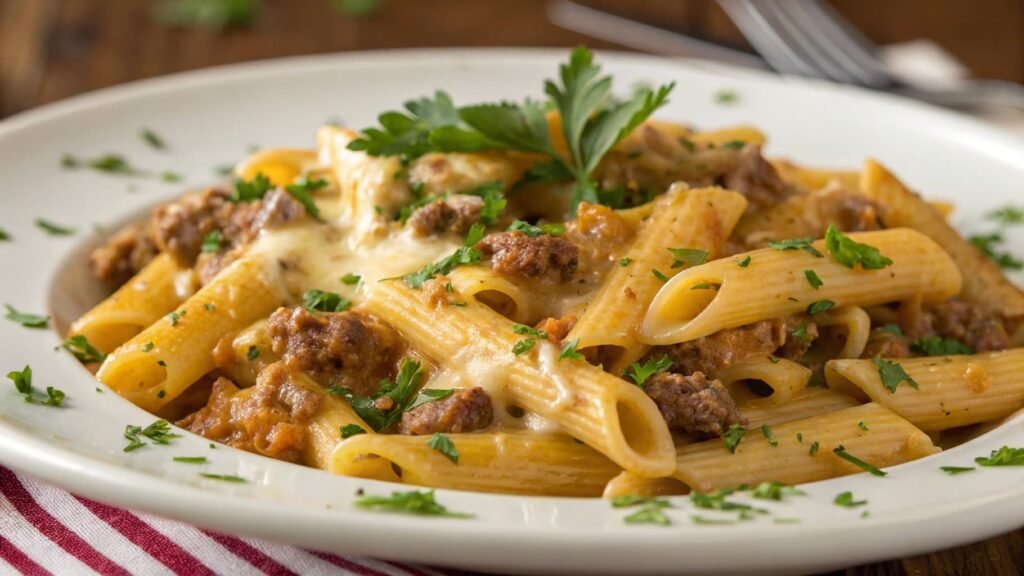My grandma Rose made the worst chicken soup you’ve ever tasted.
I know that’s not how these food stories usually start. We’re supposed to wax poetic about some perfect family recipe passed down through generations. But honestly? Her soup was terrible bland, with these huge, undercooked chunks of carrot that crunched between your teeth like little orange hockey pucks.
And yet, twenty years after she’s gone, I still make chicken soup when I’m sick. Not her recipe (thank God), but the feeling behind it—that someone cared enough to make something to heal you, that’s what I’m chasing in my soup pot.
Table of Contents
The Real Medicine in the Bowl
Let’s talk about why chicken soup actually works when you’re sick, because it’s not just some old wives’ tale your mom told you.
Last winter, I had this brutal cold that wouldn’t quit. After three days of existing on DayQuil and self-pity, my neighbor Kim dropped off a container of homemade chicken soup. “Eat this,” she commanded, in that no-nonsense way mothers develop. Within hours, I could breathe through my nose again.
Here’s what was happening: The hot steam was opening up my congested sinuses. The broth was getting me hydrated after days of barely drinking anything. The salt was replenishing what I’d lost from all that… well, let’s just say tissues were my best friend that week.
And the protein in the chicken? It was giving my immune system something to work with. When you’re sick, your body is literally fighting a war. You wouldn’t send soldiers into battle without supplies, right? Same deal.
Chicken Soup Around My Kitchen Table
My soup journey has been a series of delicious mistakes and happy accidents. I’ve collected versions from friends, travels, and late-night internet deep dives when I should’ve been sleeping.
I dated a Jewish guy in college whose mother made matzo ball soup that would make you weep. The broth was so rich it was practically golden syrup, and those matzo balls were like clouds. We broke up (his choice, not mine), and sometimes I think I miss his mother’s soup more than I miss him.
My coworker Maria brings avgolemono soup to our potlucks—this Greek lemon-egg concoction that sounds weird until you taste it. It’s creamy without cream, bright from the lemon, and somehow feels both exotic and familiar at once. The first time I tried it, I immediately asked for the recipe, which she refused to share completely. “Family secret,” she said with a wink, though she did tell me it involves whisking eggs and lemon juice together before tempering them with hot broth. I’ve tried to recreate it six times. It’s never quite right.
Then there was that awful flu during my trip to Vietnam, where the hotel owner’s wife brought me her family’s chicken soup—fragrant with ginger and star anise, with rice noodles so slippery they kept falling off my spoon. I was better by morning.
These aren’t just recipes. They’re memories, relationships, stories. They’re people showing love in the most fundamental way—through nourishment.
The Bone Truth
Can we talk about chicken bones for a second? Because this was my soup game-changer.
For years—YEARS—I made mediocre chicken soup with boneless, skinless chicken breasts because that’s what was in my freezer and I thought they were “healthier” (eye roll at my former self). My soup was… fine. Edible. The kind you eat while thinking about what you’ll have for dessert.
Then my butcher (yes, I have a butcher, his name is Frank, and he has opinions about everything) practically staged an intervention when I told him what I was doing.
“Bones,” he said, looking genuinely pained. “For the love of God, use the bones.”
He sold me chicken thighs and drumsticks at a discount just to prove his point. And damn it, Frank was right. The resulting broth was rich, golden, with this silky mouthfeel that coated your tongue. It tasted like chicken, but more—like the platonic ideal of chicken.
The science here is collagen. As bones simmer, they release collagen that transforms into gelatin in your broth. It’s the difference between soup that’s just hot flavored water and soup that feels like it’s hugging you from the inside.
The Supporting Cast: It’s Not Just About the Chicken
Let’s give some credit to the unsung heroes of chicken soup—the vegetables.
I’ve got a confession: I hate chopping onions. My eyes turn into Niagara Falls, and I always nick my fingers. But I never skip them in soup because they’re the foundation of everything good. Same with carrots and celery—that trinity of aromatics forms the backbone of flavor.
One Tuesday, I was making soup and realized I’d forgotten celery at the store. I had everything else prepped, the chicken was ready, and it was raining sideways outside. No way was I going back out. I dug through my fridge and found a sad, slightly wilted bunch of fennel. “Close enough,” I muttered, and chopped it up.
That accidental substitution is now a permanent part of my recipe. The subtle anise flavor of the fennel adds this mysterious background note that makes people say, “What IS that?” when they taste it.
Your kitchen, your rules. Some of my best cooking has come from desperation and substitution.
Homemade Broth: Worth It or Not?
Let’s be honest with each other. Making homemade broth is not always practical.
In my perfect fantasy life, I’m the kind of person who simmers bones every Sunday and has mason jars of golden broth lined up in my freezer. In reality, I have a full-time job, a kid with a soccer schedule that defies logic, and sometimes I’m just trying to get dinner on the table before everyone starts eating the furniture.
So here’s my middle ground: I make homemade broth when I can. When I can’t, I doctor up store-bought broth so it tastes more like homemade.
The trick? Sauté some extra aromatics—onion, carrot, celery, garlic—in the bottom of your soup pot before you add the packaged broth. Throw in a bay leaf, some peppercorns, maybe a parmesan rind if you’ve got one lurking in the fridge. Let it all simmer for 20 minutes before adding the rest of your soup ingredients, and I swear, no one will know you didn’t spend all day on it.
No judgment here. Sometimes the best soup is the one that actually makes it to the table.
If you’re in the mood for something even cozier, try this Bisquick Chicken and Dumplings—it’s like chicken soup’s fluffier, heartier cousin.
Broth From Scratch: Easier Than You Think
When you do have time though? Making broth from scratch is weirdly satisfying, and way simpler than people think.
Last snow day, my kid and I made broth together. I was trying to keep him off screens for at least part of the day, and he’s weirdly fascinated by cooking (though not by eating, because seven-year-olds are mysterious creatures).
Here’s what we did:
We took about 2 pounds of chicken parts—a mix of thighs, drumsticks, and wings that were on sale. Threw in a quartered onion (skin and all—the skin adds color), roughly chopped carrots and celery (no need for precision here), and a handful of peppercorns.
We covered it all with cold water, brought it to just barely a simmer, and then… we went and built a blanket fort. Because the beautiful thing about broth is that once it’s simmering, you can ignore it for hours. Just check occasionally to make sure it’s not boiling too hard.
By the time our fort had hosted tea parties for three stuffed animals and survived an attack from imaginary pirates, the house smelled amazing and the broth was done. We strained it, let it cool, and the next day we had the base for the best chicken noodle soup I’ve made in years.
My son now tells people he’s a “broth expert.” Whatever keeps him interested in something besides Minecraft.
The Can’t-Fail Classic

Here’s my cannot-screw-it-up chicken noodle soup recipe. I’ve made this while sick, exhausted, slightly tipsy, and once while on a conference call (don’t tell my boss). It always works.
You’ll need:
- 2 pounds bone-in chicken pieces (thighs are my go-to)
- 1 onion, roughly chopped (no need to be fancy)
- 2 carrots, cut however you like them
- 2 celery stalks, sliced
- 8 cups chicken broth (homemade or store-bought, no judgment)
- 1 cup egg noodles (the wide ones)
- Salt and pepper
- A handful of fresh parsley if you have it
Throw the chicken, vegetables, and broth in a large pot and bring it to a boil. Turn it down to a simmer and let it do its thing for about an hour.
Fish out the chicken pieces. They’ll be falling apart, which is perfect. Let them cool enough so you don’t burn your fingers, then shred the meat off the bones. Toss the bones (or save them for more broth if you’re that person).
While the chicken’s cooling, throw your noodles into the still-simmering soup. Let them cook until they’re tender but not mushy.
Add the shredded chicken back to the pot, taste it, and add salt and pepper until it makes you happy. Toss in the parsley at the end if you’re using it.
That’s it. Nothing fancy, but it works every time. It’s the soup equivalent of that friend who’s always there when you need them—reliable, comforting, zero drama.
Make It Your Own (Because Why Not?)

Remember how I said my grandma’s soup was terrible? Part of the problem was that she never deviated from her recipe. Same vegetables, same seasonings, same everything, every single time. Even when it was clearly not working.
Don’t be like Grandma Rose. Play with your food.
Swap out the noodles for rice. Or barley. Or those tiny little pasta stars that are technically for children but are delightful in soup.
Add herbs. Fresh dill is amazing in chicken soup. So is thyme. Rosemary can be overpowering, so go easy, but a little bit adds this pine-y essence that’s perfect in winter.
One time I had leftover roasted sweet potatoes in the fridge, and I cubed them and threw them into my soup at the last minute. The slight sweetness against the savory broth was incredible.
Some of my favorite variations:
The “I Think I’m Coming Down With Something” Soup: Add extra garlic, a thumb-sized piece of ginger, and finish with lots of lemon. It’s like chicken soup with a kick in the pants.
The “Clean Out The Fridge” Special: Whatever vegetables are about to go bad get thrown in. I’ve used bell peppers, zucchini, corn, spinach—basically anything that won’t completely dissolve. It’s different every time, and that’s the point.
The “I Need A Hug” Bowl: Make the basic soup, then add a splash of heavy cream at the end and a handful of frozen peas. It’s rich and comforting without being too heavy.
Recipes aren’t sacred texts. They’re starting points. Make the soup that you want to eat.
How to Serve Soup Like You Mean It

Soup deserves better than just being dumped in a bowl.
I have these wide, shallow bowls that I found at a thrift store that are perfect for soup—they let it cool quickly to that perfect temperature where you can actually taste the flavors instead of burning your tongue.
Add something fresh on top—herbs, a squeeze of lemon, a drizzle of good olive oil. It brightens everything up.
And please, for the love of all things delicious, serve good bread alongside. Soup without bread is like a kiss without a hug—still nice, but missing something important. It doesn’t have to be homemade (who has time?), but warm it up at least.
My friend Tasha serves her chicken soup with a surprising side—a small plate of pickles and olives. The sharp, briny flavors are an amazing contrast to the richness of the soup. I copied her immediately.
And for a hearty dinner that feels like a full-on hug, this Crockpot Loaded Steak and Potato Bake is totally worth the fork-and-knife effort.
When Soup Goes Wrong
We’ve all been there. The soup that looks nothing like what you imagined. The broth that tastes like hot water with vague chicken memories. The noodles that disintegrate into starchy oblivion.
Here’s how to fix the most common soup disasters:
Bland Soup: This is almost always a salt issue. Add it gradually, tasting as you go. Still flat? Add acida splash of vinegar or lemon juice. Still not right? Try a dash of soy sauce or a pinch of MSG (yes, MSG—it’s not the villain it was made out to be, and it adds that savory umami quality).
Greasy Broth: Made your broth, and now there’s an oil slick on top? Chill it! Refrigerate the soup, and the fat will solidify on top. Scrape it off, reheat, and you’re back in business.
Mushy Vegetables: Unfortunately, there’s no coming back from this one. Next time, add delicate vegetables later in the cooking process. For now, embrace the mushiness and purée the whole soup into a creamy concoction. Pretend that was your plan all along.
Too Salty: Add a peeled, quartered potato to absorb some salt, then discard it. Or dilute with more unsalted broth or even a bit of water. A touch of acid can also help distract from over-salting.
Overcooked Chicken: Again, no real fix except to learn for next time. But you can disguise the dryness by shredding it very finely and adding a little olive oil to the broth to give the illusion of richness.
Remember, even “failed” soup is usually still pretty decent soup. Lower your standards and grab a spoon. Tomorrow is another soup day.
What Chicken Soup Really Means
I’ve made hundreds of pots of chicken soup in my life. Some were forgettable, some were good enough, and a precious few were so perfect I still dream about them years later.
But here’s what I’ve learned: chicken soup isn’t really about the chicken, or the noodles, or whether you used homemade broth or the stuff in the box.
It’s about the act of nourishing—yourself or someone else. It’s about the way the steam rises from the pot and fogs your kitchen windows. It’s about how the whole house fills with that smell that somehow means “home,” no matter where you’re from or what your version of the soup looks like.
When my best friend had her first baby, I didn’t know what to do. I’m terrible with newborns—they terrify me with their fragility and their mysterious crying. But I knew how to make soup. So I brought her a huge pot of chicken soup and some good bread, and she texted me later saying she’d eaten three bowls standing up at the kitchen counter while the baby finally slept. “First real meal in days,” she wrote. “You saved me.”
That’s what chicken soup really is. It’s a way of saying I see you, I care about you, I want you to be well.
So the next time life gets messy, or someone you love is hurting, or you just need to remind yourself that simple things can be good things—make a pot of soup. It doesn’t have to be perfect. It just has to be made with intention.
Your soup, your story. What will you put in your pot?
Frequently Asked Questions (FAQs)
1. What makes chicken soup good for you when you’re sick?
Chicken soup helps with hydration, relieves congestion through steam, and provides nutrients like protein and electrolytes that support recovery.
2. Can I make chicken soup without homemade broth?
Yes! You can use store-bought broth and boost the flavor by sautéing aromatics like onions, garlic, and herbs before adding it.
3. What are the best vegetables to add to chicken soup?
Classic vegetables include carrots, celery, and onions, but you can also add fennel, sweet potatoes, spinach, or whatever you have on hand.
4. How long does homemade chicken soup last in the fridge?
Properly stored in airtight containers, chicken soup lasts 4–5 days in the fridge. You can also freeze it for up to 3 months.
5. Can I use chicken breasts instead of thighs in chicken soup?
You can, but bone-in thighs or drumsticks give the broth richer flavor and texture thanks to the collagen released during simmering.
Conclusion
Chicken soup is more than just a recipe—it’s a ritual of care and comfort. Whether you’re sick, tired, or just craving warmth, this bowl delivers. From rich homemade broth to creative veggie swaps, it’s endlessly adaptable.
Every pot tells a story, yours can too.
So grab a spoon, stir with love, and taste the healing.

Healing Homemade Chicken Soup
A comforting, soul-warming chicken soup made from scratch with bone-in chicken, fresh vegetables, and noodles. Whether you’re under the weather or just need a cozy bowl of goodness, this chicken soup delivers both flavor and healing vibes.
- Total Time: 1 hour 15 minutes
- Yield: 6 servings 1x
Ingredients
- 2 lbs bone-in chicken pieces (thighs and drumsticks)
- 8 cups chicken broth (homemade or store-bought)
- 1 onion, roughly chopped
- 2 carrots, sliced
- 2 celery stalks, chopped
- 3 garlic cloves, minced
- 1 bay leaf
- 1 tsp salt (adjust to taste)
- ½ tsp black pepper
- 1 cup egg noodles (or pasta of choice)
- 1 tbsp olive oil (optional, for sautéing)
- Handful of fresh parsley, chopped (optional)
- Juice of ½ lemon (optional, for brightness)
Instructions
- Sauté aromatics (optional): In a large pot, heat olive oil over medium heat. Add onion, carrots, and celery. Cook for 5 minutes until softened.
- Add chicken & broth: Place chicken pieces in the pot. Pour in broth, add bay leaf, garlic, salt, and pepper.
- Simmer: Bring to a boil, then reduce heat and simmer for 45–60 minutes, partially covered.
- Shred chicken: Remove chicken pieces, let them cool slightly, then shred the meat and discard bones.
- Cook noodles: While shredding chicken, add egg noodles to the soup and cook until tender (about 8–10 minutes).
- Combine & finish: Return shredded chicken to the pot. Stir in parsley and lemon juice if using. Adjust seasoning.
Notes
- Add ginger and extra garlic for an immune boost.
- Swap noodles for rice, quinoa, or barley.
- Use fennel or leeks for a flavor twist.
- Store in fridge for up to 5 days or freeze for 3 months.
- Avoid overcooking noodles if freezing—add fresh when reheating.
- Prep Time: 15 minutes
- Cook Time: 60 minutes
- Category: Soup
- Method: Simmering
- Cuisine: American / Comfort Food
- Diet: Gluten Free
Nutrition
- Serving Size: 1 bowl (~1.5 cups)
- Calories: 320 kcal
- Sugar: 4g
- Sodium: 780mg
- Fat: 14g
- Saturated Fat: 3.5g
- Unsaturated Fat: 9g
- Trans Fat: 0g
- Carbohydrates: 25g
- Fiber: 3g
- Protein: 28g
- Cholesterol: 95mg



